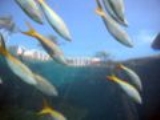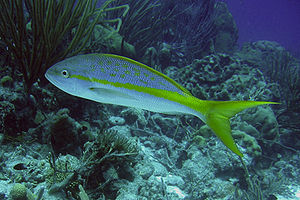
Yellowtail snapper
Encyclopedia

Species
In biology, a species is one of the basic units of biological classification and a taxonomic rank. A species is often defined as a group of organisms capable of interbreeding and producing fertile offspring. While in many cases this definition is adequate, more precise or differing measures are...
of snapper
Lutjanidae
Snappers are a family of perciform fish, mainly marine but with some members inhabiting estuaries, feeding in freshwater. Some are important food fish. One of the best known is the red snapper....
found along the North America
North America
North America is a continent wholly within the Northern Hemisphere and almost wholly within the Western Hemisphere. It is also considered a northern subcontinent of the Americas...
n coast of the Atlantic Ocean
Atlantic Ocean
The Atlantic Ocean is the second-largest of the world's oceanic divisions. With a total area of about , it covers approximately 20% of the Earth's surface and about 26% of its water surface area...
. Although they have been found as far north as Massachusetts
Massachusetts
The Commonwealth of Massachusetts is a state in the New England region of the northeastern United States of America. It is bordered by Rhode Island and Connecticut to the south, New York to the west, and Vermont and New Hampshire to the north; at its east lies the Atlantic Ocean. As of the 2010...
, their normal range is along Florida
Florida
Florida is a state in the southeastern United States, located on the nation's Atlantic and Gulf coasts. It is bordered to the west by the Gulf of Mexico, to the north by Alabama and Georgia and to the east by the Atlantic Ocean. With a population of 18,801,310 as measured by the 2010 census, it...
down through the West Indies and Brazil
Brazil
Brazil , officially the Federative Republic of Brazil , is the largest country in South America. It is the world's fifth largest country, both by geographical area and by population with over 192 million people...
.
In certain reef
Reef
In nautical terminology, a reef is a rock, sandbar, or other feature lying beneath the surface of the water ....
s, most notably in the Florida Keys
Florida Keys
The Florida Keys are a coral archipelago in southeast United States. They begin at the southeastern tip of the Florida peninsula, about south of Miami, and extend in a gentle arc south-southwest and then westward to Key West, the westernmost of the inhabited islands, and on to the uninhabited Dry...
, this beautifully colored fish
Fish
Fish are a paraphyletic group of organisms that consist of all gill-bearing aquatic vertebrate animals that lack limbs with digits. Included in this definition are the living hagfish, lampreys, and cartilaginous and bony fish, as well as various extinct related groups...
is commonly spotted among divers
Underwater diving
Underwater diving is the practice of going underwater, either with breathing apparatus or by breath-holding .Recreational diving is a popular activity...
and snorkelers
Snorkeling
Snorkeling is the practice of swimming on or through a body of water while equipped with a diving mask, a shaped tube called a snorkel, and usually swimfins. In cooler waters, a wetsuit may also be worn...
. The yellow tailed snapper is also a popular and abundant game fish
Game fish
Game fish are fish pursued for sport by recreational anglers. They can be freshwater or marine fish. Game fish can be eaten after being caught, though increasingly anglers practise catch and release to improve fish populations. Some game fish are also targeted commercially, particularly...
that makes excellent table fare. Yellowtail feed on shrimp
Shrimp
Shrimp are swimming, decapod crustaceans classified in the infraorder Caridea, found widely around the world in both fresh and salt water. Adult shrimp are filter feeding benthic animals living close to the bottom. They can live in schools and can swim rapidly backwards. Shrimp are an important...
, crab
Crab
True crabs are decapod crustaceans of the infraorder Brachyura, which typically have a very short projecting "tail" , or where the reduced abdomen is entirely hidden under the thorax...
s, worm
Worm
The term worm refers to an obsolete taxon used by Carolus Linnaeus and Jean-Baptiste Lamarck for all non-arthropod invertebrate animals, and stems from the Old English word wyrm. Currently it is used to describe many different distantly-related animals that typically have a long cylindrical...
s and smaller fish. They spawn
Spawn (biology)
Spawn refers to the eggs and sperm released or deposited, usually into water, by aquatic animals. As a verb, spawn refers to the process of releasing the eggs and sperm, also called spawning...
in groups off the edge of reefs from spring to fall, but heavily in midsummer
Midsummer
Midsummer may simply refer to the period of time centered upon the summer solstice, but more often refers to specific European celebrations that accompany the actual solstice, or that take place on a day between June 21 and June 24, and the preceding evening. The exact dates vary between different...
.
Yellowtail snapper are typically caught in 30-120 feet of water on and around reefs and other structure. The most common method of catching yellowtail snapper is with hook and line; and the use of frozen chum to attract the fish. The chum used to attract yellowtail is typically a five pound block of leftover fish parts that is ground and then frozen in to blocks. The chum is placed in to a mesh bag or metal basket that is then placed in to the water, and as the chum slowly melts, small pieces of fish will drift out and down towards the bottom, where the yellowtail typically feed. The chum attracts the fish, and keeps them near the boat for extended periods of time as well.
Light tackle is the generally accepted means of catching yellowtail snapper. Typically, the fish are relatively wary of higher-test or thicker line, and larger hooks. Most fish caught by anglers range from eight inches to thirteen or fourteen inches, although catches to sixteen inches are not uncommon. Catches larger than seventeen inches are uncommon, and catches over twenty inches are generally considered rare. Yellowtail snapper can be caught on a variety of bait, including both live and frozen shrimp, squid, and a variety of live and frozen minnows or smaller baitfish. Yellowtail snapper can be caught on artificial baits and lures, but live or frozen bait is generally preferred. Yellowtail tend to be wary fish, and the appearance of larger fish, such as dolphins or sharks can scare off schools of yellowtail snapper until the offender leaves the area.
Most anglers pursue yellowtail snapper during the warmer months, but they can be caught throughout the year. Yellowtail must be 12" in overall length to be harvested in most areas, and bag limits apply in most regions. Yellowtail snapper is highly prized for its light, flaky meat and is considered by some to be one of, if not the best of the snapper family.
External links
- http://www.flmnh.ufl.edu/fish/Gallery/Descript/YellowtailSnapper/Yellowtailsnapper.htmlYellowtail Snapper, Florida Museum of Natural HistoryFlorida Museum of Natural HistoryThe Florida Museum of Natural History is the State of Florida's official state-sponsored and chartered natural history museum. Its main facilities are located on the campus of the University of Florida in Gainesville, Florida....
]

